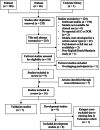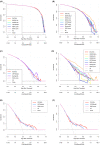Comparison of eight modern preoperative scoring systems for survival prediction in patients with extremity metastasis
- PMID: 37306656
- PMCID: PMC10358267
- DOI: 10.1002/cam4.6097
Comparison of eight modern preoperative scoring systems for survival prediction in patients with extremity metastasis
Abstract
Background: Survival is an important factor to consider when clinicians make treatment decisions for patients with skeletal metastasis. Several preoperative scoring systems (PSSs) have been developed to aid in survival prediction. Although we previously validated the Skeletal Oncology Research Group Machine-learning Algorithm (SORG-MLA) in Taiwanese patients of Han Chinese descent, the performance of other existing PSSs remains largely unknown outside their respective development cohorts. We aim to determine which PSS performs best in this unique population and provide a direct comparison between these models.
Methods: We retrospectively included 356 patients undergoing surgical treatment for extremity metastasis at a tertiary center in Taiwan to validate and compare eight PSSs. Discrimination (c-index), decision curve (DCA), calibration (ratio of observed:expected survivors), and overall performance (Brier score) analyses were conducted to evaluate these models' performance in our cohort.
Results: The discriminatory ability of all PSSs declined in our Taiwanese cohort compared with their Western validations. SORG-MLA is the only PSS that still demonstrated excellent discrimination (c-indexes>0.8) in our patients. SORG-MLA also brought the most net benefit across a wide range of risk probabilities on DCA with its 3-month and 12-month survival predictions.
Conclusions: Clinicians should consider potential ethnogeographic variations of a PSS's performance when applying it onto their specific patient populations. Further international validation studies are needed to ensure that existing PSSs are generalizable and can be integrated into the shared treatment decision-making process. As cancer treatment keeps advancing, researchers developing a new prediction model or refining an existing one could potentially improve their algorithm's performance by using data gathered from more recent patients that are reflective of the current state of cancer care.
Keywords: Asian cohort; external validation; extremity metastasis; survival prediction models.
© 2023 The Authors. Cancer Medicine published by John Wiley & Sons Ltd.
Conflict of interest statement
Each author certifies that there are no commercial associations (consultancies, stock ownership, equity interest, patent/licensing arrangements, etc.) that might pose a conflict of interest in connection with the submitted article related to the author or any immediate family members.
Figures



Similar articles
-
International Validation of the SORG Machine-learning Algorithm for Predicting the Survival of Patients with Extremity Metastases Undergoing Surgical Treatment.Clin Orthop Relat Res. 2022 Feb 1;480(2):367-378. doi: 10.1097/CORR.0000000000001969. Clin Orthop Relat Res. 2022. PMID: 34491920 Free PMC article.
-
Does the SORG Machine-learning Algorithm for Extremity Metastases Generalize to a Contemporary Cohort of Patients? Temporal Validation From 2016 to 2020.Clin Orthop Relat Res. 2023 Dec 1;481(12):2419-2430. doi: 10.1097/CORR.0000000000002698. Epub 2023 May 25. Clin Orthop Relat Res. 2023. PMID: 37229565 Free PMC article.
-
How Does the Skeletal Oncology Research Group Algorithm's Prediction of 5-year Survival in Patients with Chondrosarcoma Perform on International Validation?Clin Orthop Relat Res. 2020 Oct;478(10):2300-2308. doi: 10.1097/CORR.0000000000001305. Clin Orthop Relat Res. 2020. PMID: 32433107 Free PMC article.
-
Predictive Modeling for Spinal Metastatic Disease.Diagnostics (Basel). 2024 May 5;14(9):962. doi: 10.3390/diagnostics14090962. Diagnostics (Basel). 2024. PMID: 38732376 Free PMC article. Review.
-
Utility of prediction model score: a proposed tool to standardize the performance and generalizability of clinical predictive models based on systematic review.J Neurosurg Spine. 2021 Feb 26;34(5):779-787. doi: 10.3171/2020.8.SPINE20963. Print 2021 May 1. J Neurosurg Spine. 2021. PMID: 33636704 Review.
Cited by
-
CORR Insights®: What Factors Are Associated With Implant Revision in the Treatment of Pathologic Subtrochanteric Femur Fractures?Clin Orthop Relat Res. 2025 Mar 1;483(3):485-487. doi: 10.1097/CORR.0000000000003370. Epub 2024 Dec 31. Clin Orthop Relat Res. 2025. PMID: 39787403 No abstract available.
-
Differential survival outcomes in upper versus lower extremity metastatic bone disease: a retrospective comparative cohort analysis.J Orthop Surg Res. 2025 Jul 26;20(1):706. doi: 10.1186/s13018-025-06079-2. J Orthop Surg Res. 2025. PMID: 40713755 Free PMC article.
-
Are Current Survival Prediction Tools Useful When Treating Subsequent Skeletal-related Events From Bone Metastases?Clin Orthop Relat Res. 2024 Sep 1;482(9):1710-1721. doi: 10.1097/CORR.0000000000003030. Epub 2024 Mar 22. Clin Orthop Relat Res. 2024. PMID: 38517402 Free PMC article.
References
-
- Coleman RE. Clinical features of metastatic bone disease and risk of skeletal morbidity. Clin Cancer Res. 2006;12(20 Pt 2):6243s‐6249s. - PubMed
-
- Coleman RE. Metastatic bone disease: clinical features, pathophysiology and treatment strategies. Cancer Treat Rev. 2001;27(3):165‐176. - PubMed
-
- Bongers MER, Groot OQ, Thio Q, et al. Prospective study for establishing minimal clinically important differences in patients with surgery for lower extremity metastases. Acta Oncol. 2021;60(6):714‐720. - PubMed
-
- Groot OQ, Lans A, Twining PK, et al. Clinical outcome differences in the treatment of impending versus completed pathological long‐bone fractures. J Bone Joint Surg Am. 2022;104(4):307‐315. - PubMed
-
- Rompe JD, Eysel P, Hopf C, Heine J. Metastatic instability at the proximal end of the femur. Comparison of endoprosthetic replacement and plate osteosynthesis. Arch Orthop Trauma Surg. 1994;113(5):260‐264. - PubMed
Publication types
MeSH terms
LinkOut - more resources
Full Text Sources
Research Materials

